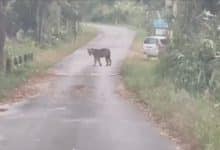Fungi frenzy: Termite mound sprouts local ‘mushroom’ for interest

A large number of mushrooms sprouting from a termite mound behind a monk’s quarters today attracted a significant amount of local interest. Two elderly women plan to cook the mushrooms and offer them to the monks as alms.
Termite mushrooms, known locally as “hed plouk,” were discovered sprouting on a termite mound behind the quarters of a monk named Sumet Sumetho at the Saen Suk Temple in Ban Don Saen Suk, Khon Buri district, Nakhon Ratchasima province. The sight of hundreds of mushrooms growing in such abundance has drawn considerable attention from villagers since yesterday.
Villagers noted that while it is not uncommon for mushrooms to grow on termite mounds, the sheer number and the size of these mushrooms make this a rare and noteworthy event. The mushrooms are described as being particularly large and plump, making them even more intriguing to the local community.
Sumet Sumetho, who resides in the aforementioned quarters, yesterday, August 8, invited two elderly women from the nearby area, 77 year old Arun, and 72 year old Rian, to gather the mushrooms. The monk suggested that the mushrooms be harvested for culinary use rather than going to waste.
The mushrooms today had grown to full maturity, with some additional ones sprouting. Sumet Sumetho advised the women to leave their roots intact to ensure future growth. Arun and Rian carefully collected all the mushrooms, adhering to the monk’s instructions, and counted a total of 118 mushrooms.
Arun and Rian plan to clean the mushrooms and store them in the refrigerator. They intend to cook the mushrooms into a dish tomorrow morning and offer it to the monks at Saen Suk Temple as part of their almsgiving, thus performing a meritorious act.

Arun and Rian expressed their belief that the enigmatic appearance of such a large number of mushrooms on the termite mound, which has garnered significant attention and even media coverage, might be a sign from a higher power.
They believe this phenomenon highlights the fertility of their village, named “Don Saen Suk,” and the temple “Saen Suk.” They speculate that this might be a divine invitation for more people to visit the temple, see its needs, and contribute to its upkeep and enhancement.
The two women’s intentions reflect a deeper cultural and spiritual connection to their community and their faith. Their act of offering the mushrooms to the monks is not just a practical use of a natural resource but a meaningful gesture of piety and community spirit.

Latest Thailand News
Follow The Thaiger on Google News:


























